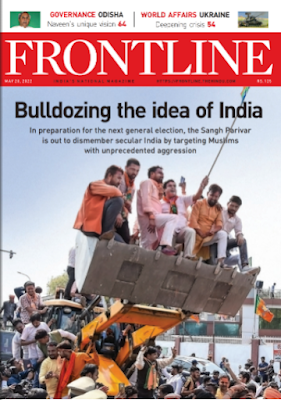Bulldozer Politics
Media Watch
The latest issue of Frontline
magazine focuses on the bulldozer politics that has taken India captive. More
than half of the magazine is dedicated to the topic: Bulldozing the idea
of India. R Vijaya Shankar sets the tone in the editorial by asserting that the problem in
India is not Muslim appeasement as alleged by the right wing. It is “the majoritarian
bigots who are appeased by allowing them to hound Muslims, attacking their
places of worship, bulldozing their residences and means of livelihood, their
cultural symbols, their food and sartorial choices.” The present India is the
culmination of the century-old project founded on the concept of cultural
nationalism by Savarkar in 1923, before Jinnah ever proposed a separate nation for
Muslims.
In the lead story, ‘Bulldozing
the idea of India,’ Venkitesh Ramakrishnan argues that the bulldozer has now
become “a hideous symbol of communal aggression.” It was first employed in UP
to withstand the challenges posed by SP and its allies during the assembly
elections. Madhya Pradesh, Karnataka and Delhi embraced it soon. The underlying
objective is to polarise the country along Hindu-versus-the rest line.
A G Noorani’s
scholarly article, ‘RSS
and Gandhi,’ ridicules the right wing’s attempts to appropriate the
legacies of Gandhi, Ambedkar and Subash Chandra Bose. “All of them despised the
Sangh Parivar,” asserts Noorani while highlighting the irony of the assassins
of Gandhi staking a claim to his legacy. The author concludes the article with
a quote from Ambedkar. “If Hindu Raj does become a fact, it will, no doubt, be
the greatest calamity for this country. No matter what the Hindus say, Hinduism
is a menace to liberty, equality and fraternity…. Hindu Raj must be prevented
at all costs.”
The next
article is on the Hindutvaisation
of education by T K Rajalakshmi. The New Education Policy (NEP) is all
set to brainwash the young minds in schools as well as universities. Hindutva
ideas and attitudes are pumped into textbooks. The Bhagavad Gita is replacing
moral science textbooks. Leftist historians like R S Sharma and Irfan Habib are
kicked out of universities. The attempts to despise the Mughals and the British
are too blatant. While the NEP acknowledges that the future will be
technology-driven and hence our focus should be on equipping students with relevant
skills, the means for achieving that is “taking inspiration from the ancient
Indian traditions”! The writer laments that “Ignored totally in the process is
the fact that exclusion of the majority from education was also an integral
element of the ancient tradition that sanctified an extremely hierarchical
social order.”
Rajalakshmi
also draws the reader’s attention to the Modi government’s objective of
privatising education and handing over the sacred task of moulding the young
generation to Hindutva organisations.
In the
article titled ‘Media
sellout,’ Ziya Us Salam warns of TV news anchors “seeking to outdo one
another in propagating the government’s line.” From Aaj Tak to News 18 to India
TV, the media in India today is going out of its way to paint the government in
golden hues, turning a blind eye to the absence of the rule of law. It is
rather shocking to note that the Indian media didn’t think it necessary to ask
why the government and the local administration did not follow rules in the recent
eviction or demolition drives.
The next
article is ‘Force-feeding
vegetarianism.’ Now in India, the government decides what its people can
eat. The sale of meat is banned during Navaratri in parts of UP. More and more
regulations keep coming up about food. The South Delhi Mayor went to the extent
of almost seeking a ban on onion and garlic since “99 per cent of households
did not use” them! The BJP’s student wing, ABVP, will now decide what students
can eat in college hostels. The obvious fact is that there are more non-vegetarians
in India than vegetarians. Then why this brouhaha about food? It is just
another way to attack a particular minority community.
Towards the
end, there is a very elaborate section of the cover story that focuses on the
various state government’s
attacks on minority communities.
In ‘Fallacy of the Hindutva project,’
Shamsul Islam argues that “With Sangh Parivar rulers pitting one section of Indians
against the other, there is no need of any foreign enemy to undo a democratic-secular
India.” A very interesting fact pointed out in this article is that there were many
Rajputs and Brahmins employed as high-ranking officials by the Mughals. Yes, some
of the Mughal emperors were diabolic creatures. That doesn’t make all Muslims
devils.
Did the
Mughals really persecute the Hindus and seek to decimate that community? If
that were true, would there have been a majority Hindu population in the
British India? Shamsul Islam raises a lot of such questions and provides
answers too.
The long ‘cover story’ ends with a look at what some governors are doing in states that are not governed by the BJP. Instead of helping build up meaningful relations between the state and the Centre, these “glorified ciphers” (governors) are acting as the stooges of the Leader at the Centre.
 |
| From Frontline's Editorial |
PS. Media
Watch will be a weekly feature on this blog.

Hari OM
ReplyDeleteFirst, thank you for the introduction to a magazine of which I was unaware.
Second, thank you for this breakdown of major articles.
Third, am looking forward to future media reports from you!!! YAM xx
Frontline is a leftist magazine published by The Hindu group. It maintains high standards in journalism.
Delete